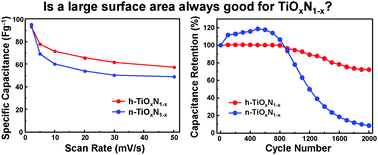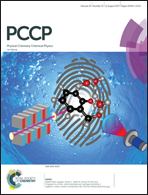The influence of surface area, porous structure, and surface state on the supercapacitor performance of titanium oxynitride: implications for a nanostructuring strategy†
Abstract
A recent surge of interest in metal (oxy)nitride materials for energy storage devices has given rise to the rapid development of various nanostructuring strategies for these materials. In supercapacitor applications, early transition metal (oxy)nitrides have been extensively explored, among which titanium oxynitride stands out due to its great potential for charge storage. Despite recent advances in supercapacitors based on titanium oxynitride, many underlying factors governing their capacitive performance remain elusive. In this work, nanostructured titanium oxynitride is prepared by firing an organic–inorganic hybrid precursor under a hot ammonia atmosphere, and the influence of its physical characteristics on the supercapacitor performance is investigated. New insights into the effects of surface area, porous structure, and surface state of titanium oxynitride on the supercapacitor performance are revealed through which a comprehensive understanding about the capacitive behavior of titanium oxynitride is provided. In addition, the implications of these insights for a nanostructuring strategy striving for higher capacitance and improved stability are discussed.



 Please wait while we load your content...
Please wait while we load your content...